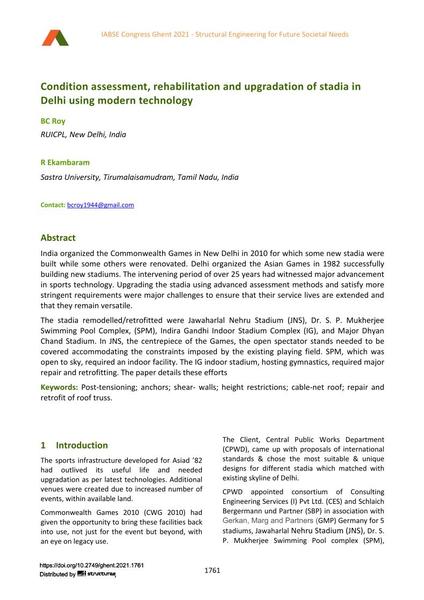Condition assessment, rehabilitation and upgradation of stadia in Delhi using modern technology

|
|
|||||||||||
Détails bibliographiques
| Auteur(s): |
B. C. Roy
(RUICPL, New Delhi, India)
R. Ekambaram (Sastra University, Tirumalaisamudram, Tamil Nadu, India) |
||||
|---|---|---|---|---|---|
| Médium: | papier de conférence | ||||
| Langue(s): | anglais | ||||
| Conférence: | IABSE Congress: Structural Engineering for Future Societal Needs, Ghent, Belgium, 22-24 September 2021 | ||||
| Publié dans: | IABSE Congress Ghent 2021 | ||||
|
|||||
| Page(s): | 1761-1770 | ||||
| Nombre total de pages (du PDF): | 10 | ||||
| DOI: | 10.2749/ghent.2021.1761 | ||||
| Abstrait: |
India organized the Commonwealth Games in New Delhi in 2010 for which some new stadia were built while some others were renovated. Delhi organized the Asian Games in 1982 successfully building new stadiums. The intervening period of over 25 years had witnessed major advancement in sports technology. Upgrading the stadia using advanced assessment methods and satisfy more stringent requirements were major challenges to ensure that their service lives are extended and that they remain versatile. The stadia remodelled/retrofitted were Jawaharlal Nehru Stadium (JNS), Dr. S. P. Mukherjee Swimming Pool Complex, (SPM), Indira Gandhi Indoor Stadium Complex (IG), and Major Dhyan Chand Stadium. In JNS, the centrepiece of the Games, the open spectator stands needed to be covered accommodating the constraints imposed by the existing playing field. SPM, which was open to sky, required an indoor facility. The IG indoor stadium, hosting gymnastics, required major repair and retrofitting. The paper details these efforts |
||||
| Mots-clé: |
mouillages
|
||||
| Copyright: | © 2021 International Association for Bridge and Structural Engineering (IABSE) | ||||
| License: | Cette oeuvre ne peut être utilisée sans la permission de l'auteur ou détenteur des droits. |
||||
